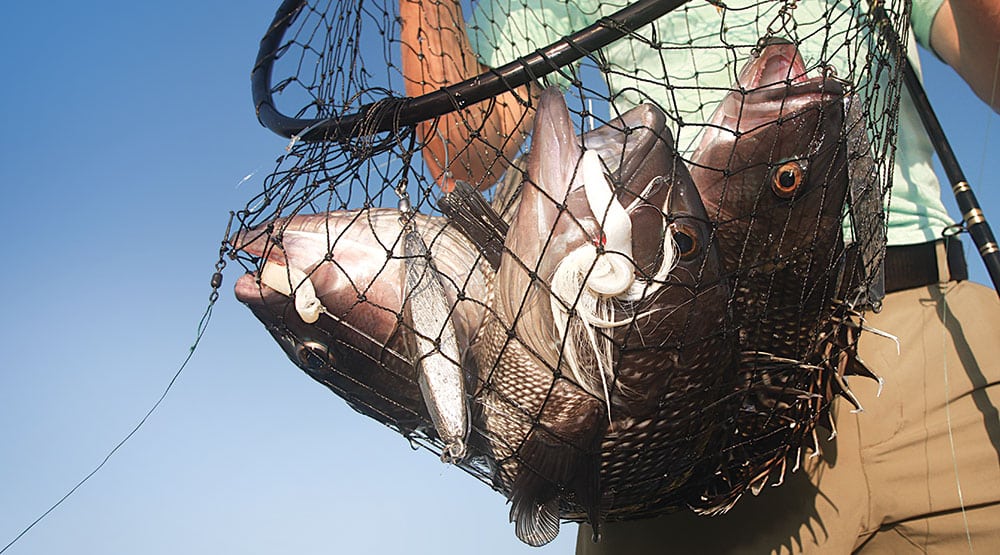
Marco DeStefano tightened his line, lifted his rod and set the hook. “I had a good feeling about this spot,” he said as a 7-pound fluke hit the deck.
We started the morning looking for big summer flatties in 90-foot depths at the Cartwright Grounds southeast of Montauk Point, which had been the doormat hot spot for several consecutive days. We then moved inshore to the Frisbees area to ice another keeper and several black sea bass. One more move put us tight against the beach, where 30 feet to the seafloor proved to be the magic number.
“It is an amazing place,” says DeStefano, “For consistency, variety and big fish, I don’t think there is anywhere between New Jersey and Maine that outshines this place.”
Topography and Seas
The ocean bottom here is scoured with cuts and gouges, hills and valleys, ledges and shoals, boulders and rock piles. A huge deposit of ancient terminal moraine pushes out toward the open Atlantic while bottlenecking the tides of both Long Island and Block Island sounds. The rapid changes in depth and structure cause the strong currents, sharp rips, and a vibrant, sea.
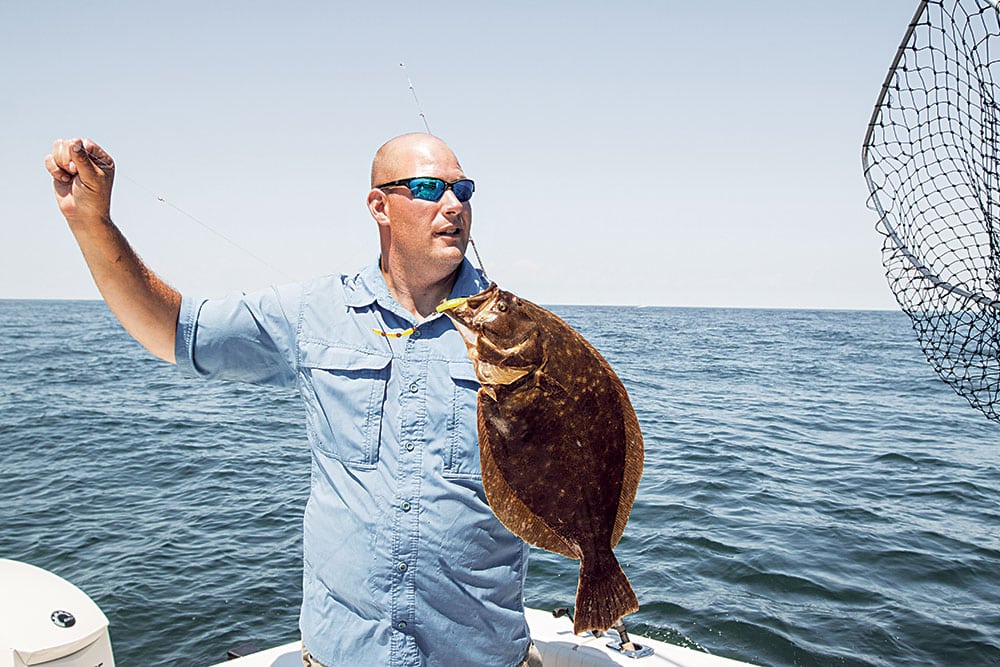
The combination of location, rough bottom and varied depths makes Montauk both a captain’s challenge and a fisherman’s nirvana. While you can negotiate the inshore scene in a 19-foot center console under mild conditions, you’ll need a sturdy vessel to feel comfortable in anything more than what local skippers refer to as “a little chop.”
 |
Subscribe Now and Save 63%
Advertisement
|
Incoming Flatties
Serious inshore action at Montauk starts with summer flounder, since the season opens in May. These early runners are often big but skinny fish, with 5- and 6-pounders not uncommon, and keepers the rule more than the exception. As May rounds into June, a second influx of big fish top the 10-pound mark and a surprising number of 6- to 8-pounder pulled from 40- to 50-foot depths.
August and September are when you prospect for the doormat of a lifetime. Late summer last year saw double-digit fluke hitting the deck nearly every day the fleet went out. While the top fish checked in at just under 15 pounds, it’s likely even larger ones are there. The Frisbees, after all, is where the late Capt. Charlie Nappi caught the world-record fluke back in 1977, a 22-pound, 7-ounce behemoth.
| Species | Season | Bait/Lure | Hot Spots |
|---|---|---|---|
| Black Sea Bass | July - October | Squid strips, clams, bucktails tipped with squid, diamond jigs | Inner Frisbees, all fluke grounds, plus federal waters offshore at Outer Cartwright and Block Island when permitted |
| Blackfish | October/November | Green crabs, white crabs | Block Island, south side of Fishers Island, select rock piles, mussel beds and ledge areas |
| Bluefish | June - October | Diamond jigs, umbrella rigs, poppers, live bait | All rips, follow the bait |
| Cod | February - March | Skimmer clams, diamond jigs | Apple Tree, Coxes Ledge and broken bottom |
| False Albacore | September/October | Deadly Dick, Hogy Epoxy Jig, AVA 007, Albie Snax | Under the light, directly in front of Montauk Harbor; follow the bait |
| Fluke | Mid-June - Late August | 6-inch Gulp! grub in Nuclear Chicken pattern on a 3-ounce bucktail; 7- to 10-inch strip of bluefish belly, squid or sea robin; Panther Martin Fluke Train attached to standard bottom rig | Cartwright Grounds, Frisbees, Radar Tower, North Rips, South Side |
| Scup | June - August | Clams, squid, bucktails tipped with Gulp! | Cherry Harbor, various rock piles on South Side of Montauk |
| Sharks | June - August | Bluefish fillet or live bluefish | Butterfish Hole, The Dump |
| Stripers | July and August | Parachute lures, tins, bucktails, live eels, swimbaits | The Elbow, Great Eastern and various rips around Montauk Light |
| Tuna | July and August | Chunk baits after dark, trolled spreader bars during daylight hours | Jennie’s Horn on out to the Fishtails |
Think big in terms of your fluke rigs and setups here. Use a dropper loop to secure a 5/0 wide-gap or straight-shank in-line Octopus-style hook on a 20- to 30-inch leader of 40-pound-test fluorocarbon line 6 inches above a 6- to 10-ounce bank sinker. For bait, add a strip of sea robin or bluefish belly that looks big enough to choke a 20-inch fish. You can also try a bucktail using the lightest jig you can get away with, generally 2 or 3 ounces, tipped with a 6-inch Berkley Gulp! curly-tail in Nuclear Chicken. Add a teaser hook on a short dropper loop about 12 inches above the bucktail if you like.
“Don’t just drift around aimlessly,” advises DeStefano. “Target structure, dips and ridges for the biggest fluke.”
Bucktail-and-Teaser Rig
A tandem rig of bucktail jigs, with the lightest placed 12 to 20 inches above the heaviest, and both lures tipped with a brightly colored, scented soft-plastic tail like the Berkley Gulp! Saltwater Jerk Shad or Swimming Mullet — in Nuclear Chicken color scheme — often proves deadly on trophy fluke and other bottomfish.
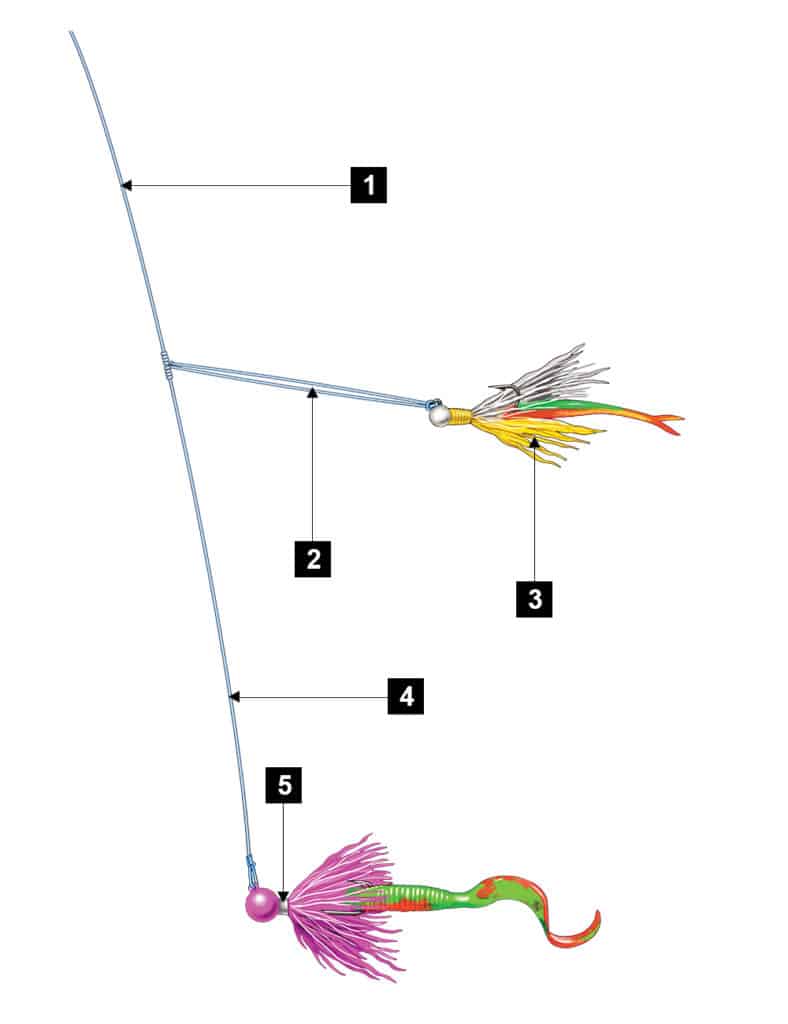
Rigging Details
1.) 30-pound fluoro leader
2.) 8-inch dropper loop
3.) Lighter bucktail jig with Gulp! Jerk Shad
4.) 12 to 20 inches of 30-pound fluoro
5.) 2- to 6-ounce bucktail jig with Gulp! Swimming Mullet
Big Bass in the Mix
Right on the tails of the fluke, striped bass arrive by May and set up in such famous haunts as the Elbow, Great Eastern, Pollack Rip, and under the light. The early bass, with a few weighing up to 30 pounds, respond best to trolled parachute lures, tube lures and umbrella rigs. The June moon offers a shot at even bigger bass, with some topping the 40-pound mark, and maybe even a fish or two tipping the scales at 50 or more.
As the waters warm, striper action shifts from daytime to the graveyard shift on live eels or bucktails tipped with pork rinds or Fat Cow Jig Strips or Otter Tails fished on three-way rigs. It's always possible to live-line or chunk a few big fish during the day on bunker or other legal-size striper favorites if you anchor up-tide of a prominent, mussel-covered hump or large boulder.
Autumn Options
The summer is great at Montauk, but fall is fantastic. Everything from scup to stripers slidesg down the coast toward the south and Montauk Point serves as a staging area. Throughout October and into early November, stripers and bluefish — along false albacore — tear into migrating bait with a fury. Sea bass and scup race each other for tidbits of squid or clam to fatten up before winter.
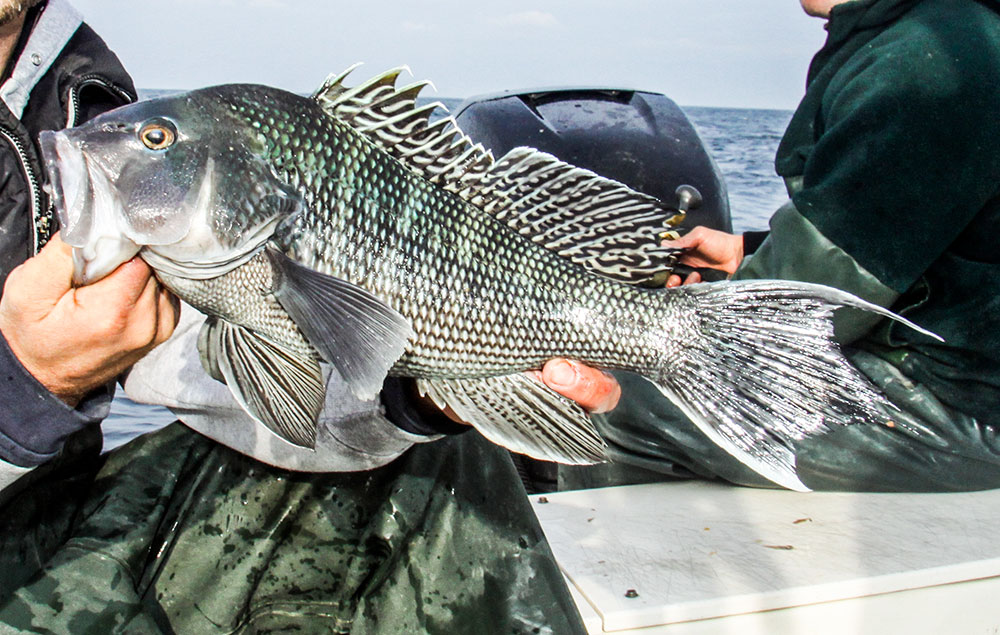
Keep in mind, Montauk is big water. Almost any rip can stand straight up and roar when southerly or easterly winds push hard against an ebbing tide.
“Everything about Montauk is amazing,” sums up DeStefano, “from the swells, to the structure, to the payoffs.” If you are new to these waters, take a charter or two to look around and get a feel for the place before heading out on your own, and never leave port undergunned.
Live-Eel Rig
Few baits tempt trophy striped bass like a big eel. Hook a live one (the bigger, the better) through both jaws on a 6/0 straight-shank hook, and fish it on a 5-foot dropper of 50-pound fluorocarbon, 12 inches above a 6- to 12-ounce bank sinker to position the bait off the bottom.
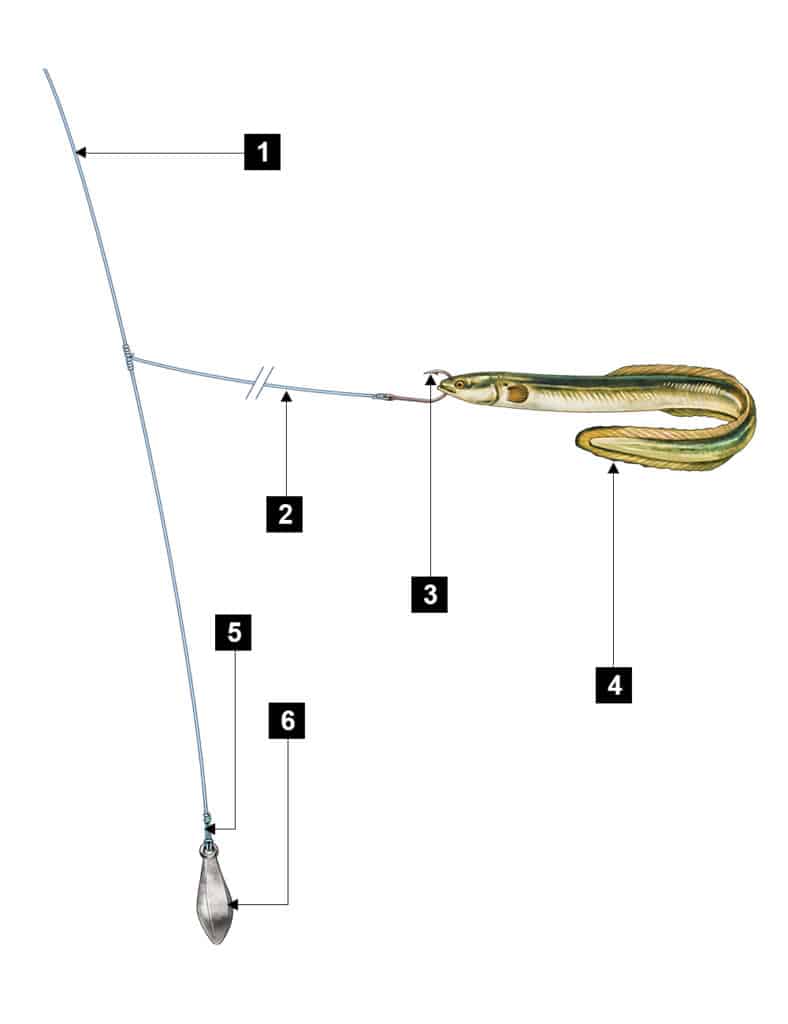
Rigging Details
1.) 4 to 6 feet of 50-pound fluoro leader
2.) 5-foot, 50-pound fluoro dropper
3.) 6/0 hook, straight-shank
4.) Live eel
5.) Loop knot to girth-hitch sinker
6.) 6- to 12-ounce bank sinker
SWS Planner
What: Trophy fluke, black sea bass, and stripers
Where: Rips surrounding Montauk Point, New York
When: June to mid-September for fluke, through October for stripers
Who: Anglers on sturdy boats to handle the area's choppy seas. Booking a local pro is a great alternative.
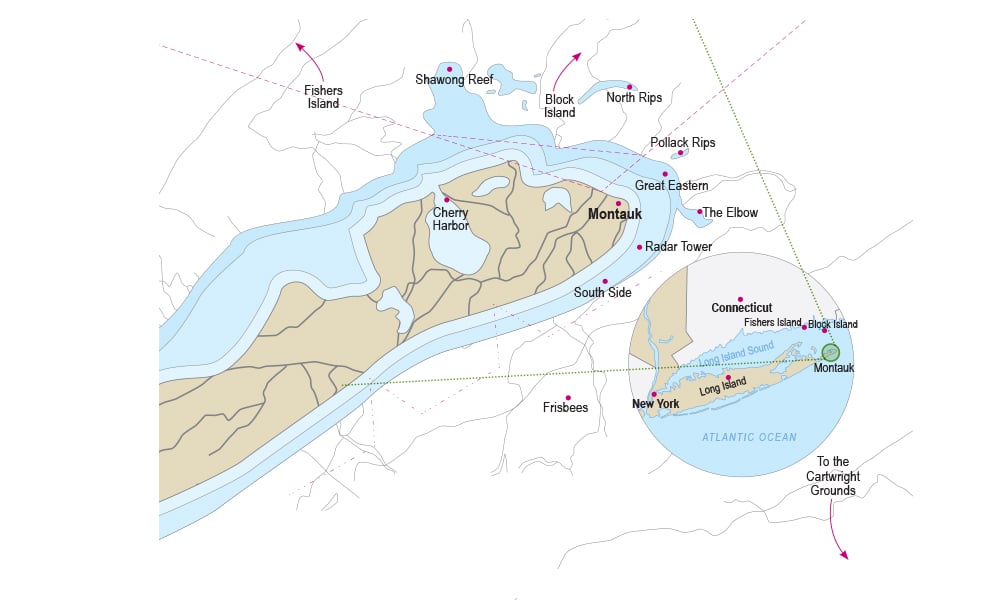
Three Montauk Guides
• Capt. Pete Casale, My Mate Charters, 917-543-3115, mymatecharterboat.com
• Capt. Mark Marose, 516-885-1932, captmarkmontauk.com
• Capt. Tom Mikoleski, Grand Slam Charters, 516-457-5298, montaukstriperfishing.com
• Capt. Jamie Quaresimo, Miss Montauk (open boat), 631-668-1545, missmontauk.com
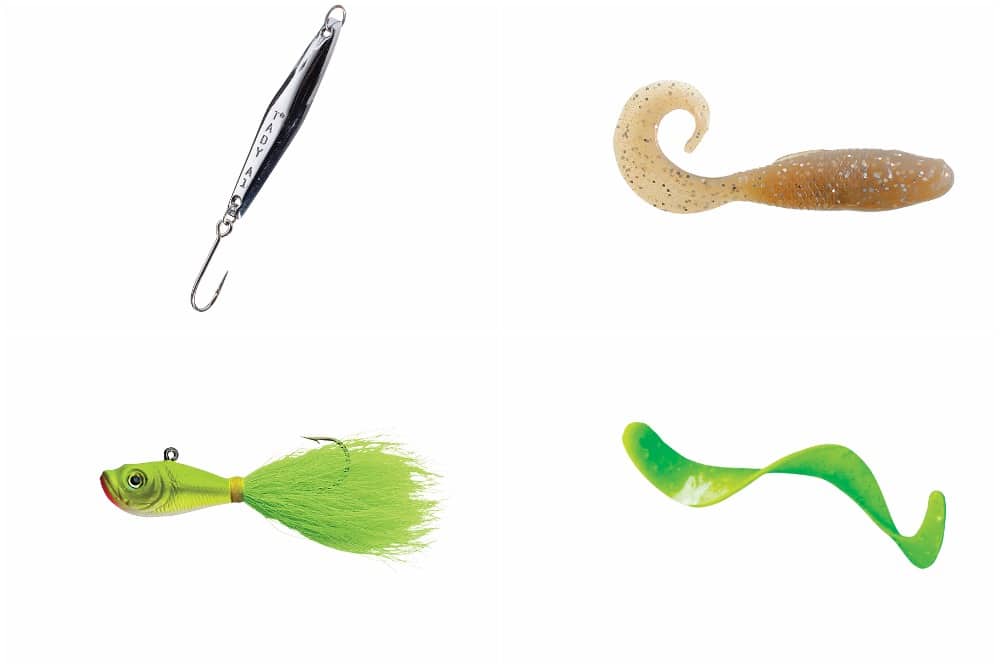
Top right: Berkley's Gulp! Swimming Mullet adds action and scent to any bucktail or lead-head.
Bottom left: The Spro Andrus Bucktail Jig's various weights and colors appeal to an array of game.
Bottom right: The Otter Tail Curly Long's lively undulation entices even wary fish into striking. Courtesy
SWS Tackle Box
Rods: Conventional with fast tips and plenty of backbone for heavy sinkers and jigs
Reels: Conventional 20/30 series for fluke and black sea bass, 30/40 series for stripers
Line: 20- to 30-pound braid for fluke, 50- to 60-pound braid for stripers
Lures: Bucktails, 2- to 3-ounce tipped with 6-inch Berkley Gulp! grubs in Nuclear Chicken for fluke, or similar bucktails tipped with Fat Cow Trailers for stripers, and diamond jigs for black sea bass.
Bait: Strips of squid, sea robin or bluefish belly for fluke; squid or clams for black sea bass; stripers prefer eels, the larger, the better.
Rigs: 2- to 6-ounce bucktail with a teaser 12 to 20 inches above for fluke; 5 feet of 50-pound mono leader with a 6/0 straight-shank hook 12 inches above a 6- to 12-ounce sinker for stripers; 2- to 4-ounce diamond jig with a single 6/0 hook tipped with clam for black sea bass.










